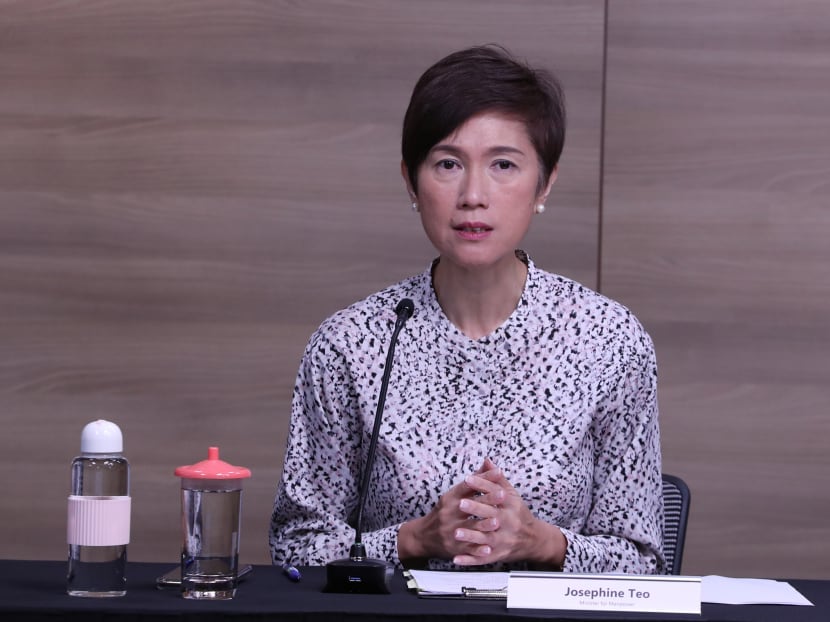24,000 placed in jobs and training opportunities, of which 40% are PMETs
SINGAPORE — Some 24,000 jobseekers have been placed in jobs and training opportunities created under the SGUnited Jobs and Skills Package since end-July, Manpower Minister Josephine Teo said on Tuesday (Aug 11).

Manpower Minister Josephine Teo speaks at a press briefing following the release of Singapore’s second quarter economic figures, Aug 11, 2020.
- 24,000 out of 92,000 new jobs and training opportunities have been filled
- About 40 per cent of these were filled by PMETs although 70 per cent of all opportunities were created for PMETs
- Filled places include 13,800 short-term jobs lasting less than a year
SINGAPORE — Some 24,000 jobseekers have been placed in jobs and training opportunities created under the SGUnited Jobs and Skills Package since end-July, Manpower Minister Josephine Teo said on Tuesday (Aug 11).
About 40 per cent of these placements were taken up by professionals, managers, executives and technicians (PMETs), even though the majority — 70 per cent — of all the available opportunities were created for this group.
“For matching of PMETs, it tends to be less straightforward because the host companies or the employers are looking for a better match in terms of skill, in terms of experience as well as in terms of the wage expectations,” Mrs Teo said.
She was speaking at a press briefing following the release of Singapore’s second quarter economic figures.
Mrs Teo said that among the filled positions, about 13,800 of them were for “short-term opportunities” including those for less than a year, while the rest were for “long-term positions”.
The National Jobs Council, which is overseeing the S$2 billion Government jobs package, has worked with employers to commit to more than 92,000 opportunities in total.
These opportunities include short- and long-term jobs, traineeships, and attachment opportunities.
Around 50,000 opportunities have been offered by public sector agencies or subsidised by the Government, with another 42,000 jobs offered by the private sector.
Slightly under half (47 per cent) of these opportunities were for short term jobs and training programmes under a year.
The Government had said in May it aimed to create nearly 100,000 of such opportunities.
Amid the slowdown in hiring due to Covid-19, Mrs Teo urged jobseekers to consider the opportunities available, even if they may not be familiar with the industry or if the position is not at the level they are looking for.
Highlighting the manufacturing industry as an example, she said the Singapore Business Federation estimates at least 1,000 open positions in the manufacturing sector, with pockets of hiring in the electronics and precision engineering sub sectors.
The ministry will feature more of these sectors that are still hiring in future weekly updates on the job situation, Mrs Teo said.
Subsequent reports will also include other key employment indicators, such as cost saving measures adopted by companies.
To help match jobseekers to these hiring sectors, Workforce Singapore conducted 59 outreach and engagement activities such as career workshops for some 13,000 jobseekers in July.
Of these sessions, 11 were walk-in interviews where more than 200 jobseekers were shortlisted for jobs in sectors such as early childhood education, food and beverages, retail, logistics and manufacturing.
Information kiosks on these opportunities created under the jobs package have also been deployed almost every week at various neighbourhoods, reaching out to more than 5,700 individuals with more than half of them aged 40 and above.
“We recognise that it takes effort to bounce back, but that is what we must do in these times. Be very resilient and know that you don’t walk the journey alone,” Mrs Teo said.
“There will be career coaches, career ambassadors supporting you, and government schemes backing you, giving support to companies to consider you.”
She also urged companies to be willing to adjust work conditions and make use of government schemes to hire more locals, even if they may not be as receptive to these jobs.
“Especially for employers, we would like to encourage them to consider candidates even if they are not too young, or may not look like their CVs (curriculum vitae) have a perfect fit with the job role.”
Asked if the ministry will do more to improve job matching for older PMETs, Ms Teo said the Government is trying to get more companies to make their traineeship opportunities — originally created for fresh graduates — available to mid-career PMETs as well.
This is because middle-aged PMET jobseekers, having spent many years building up their career, may be hesitant to transfer to new industries which they are unfamiliar with, even though there is a shortage of jobs in the industry they were previously employed in.
Company attachments through these traineeship programmes would help these workers transition into new industries, she said.
In response to a question about the possibility of extending the Jobs Support Scheme, where the Government helps employers offset employee wages, Mrs Teo said that the Government is “actively looking” into it and Deputy Prime Minister Heng Swee Keat, who is also Finance Minister, will address this soon.








